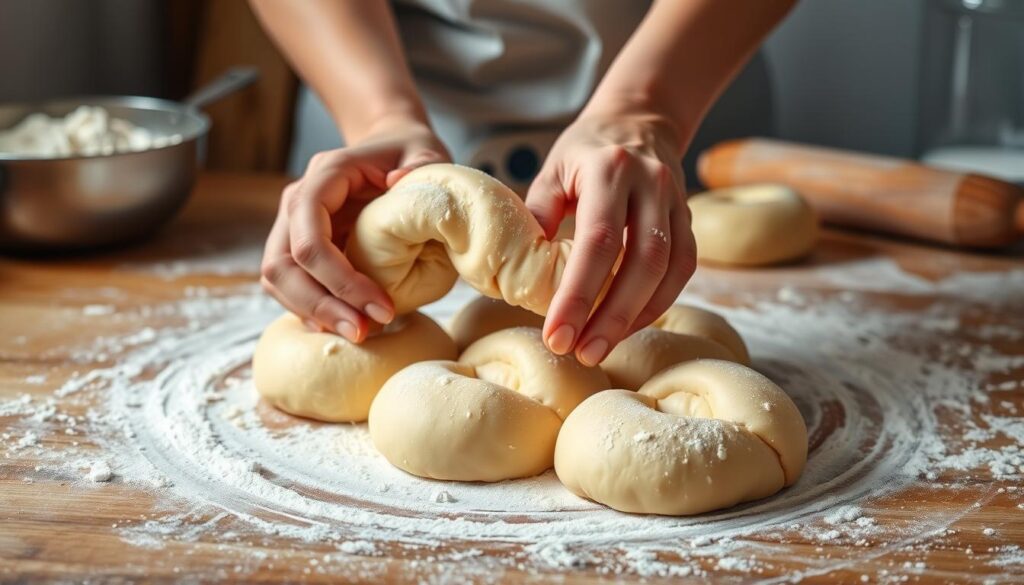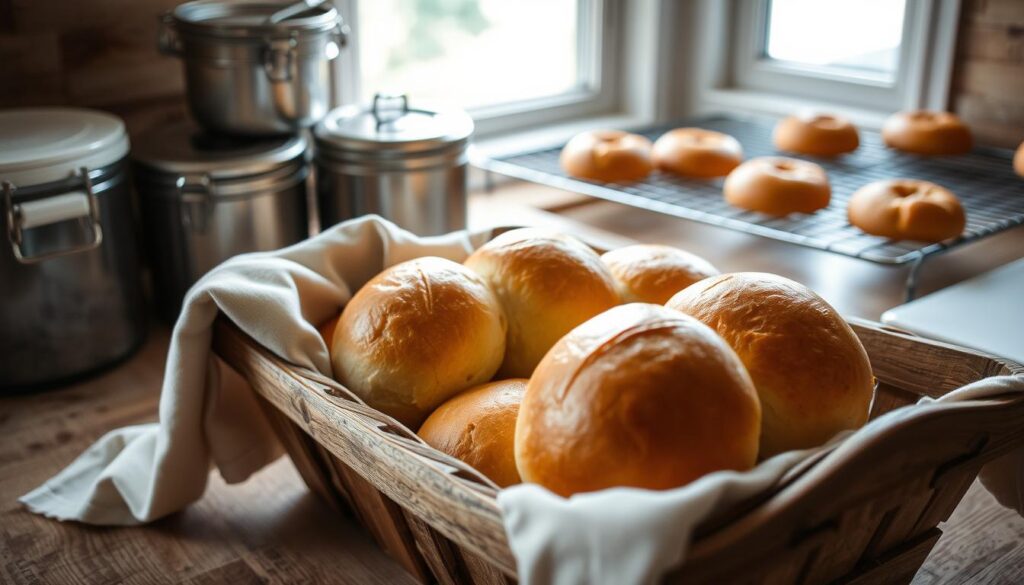The smell of freshly baked brioche rolls is amazing. These soft buns are perfect for any time. They’re filled with the rich taste of milk, eggs, and butter.
In this guide, we’ll show you how to make these delicious homemade brioche rolls. You’ll get to enjoy the joy of baking from scratch.
Table of Contents
Understanding Brioche Rolls: The Perfect Enriched Dough
Brioche rolls are a French delight that stand apart from regular bread. They are soft and pillowy, with a rich, buttery texture. This is thanks to their special dough.
What Makes Brioche Different from Regular Bread
Brioche dough has more eggs, butter, and milk than regular bread. These ingredients make the rolls tender and almost cake-like. They also give the rolls a golden-brown crust.
The Science Behind Rich, Buttery Texture
The science behind brioche’s texture is fascinating. The dough’s fats and gluten interact in a special way. This makes the bread tender and less chewy.
Key Ingredients That Define Brioche
- All-purpose flour: Provides the foundation for the dough’s structure.
- Whole milk: Adds richness and moisture to the dough.
- Eggs: Enrich the dough, contributing to the soft, tender crumb.
- Honey: Lends a subtle sweetness to balance the savory notes.
- Instant yeast: Ensures the dough rises to perfection.
- Salt: Enhances the overall flavor profile.
- Unsalted butter: Imparts the signature buttery taste and tender texture.
These ingredients come together to make brioche rolls’ unique. They are soft, tender, and full of buttery goodness.
Essential Ingredients for Milk Brioche Rolls
To make delicious milk brioche rolls at home, you need the right ingredients. These include all-purpose flour, whole milk, eggs, honey, instant yeast, Diamond Crystal Kosher Salt, and unsalted butter. Each one is crucial for the brioche’s rich, buttery taste and soft texture.
All-purpose flour gives brioche its unique chew. Whole milk adds moisture and a creamy feel. Eggs make the dough richer, and honey sweetens it while feeding the yeast for better rising.
Instant yeast is the best choice for brioche because it rises quickly. It makes the dough soft and fluffy. Diamond Crystal Kosher Salt balances the sweetness and richness of the dough, enhancing its flavor.
Unsalted butter is key for the brioche’s decadent taste and tender crumb. It also gives the dough its signature sheen.
Getting the right amounts and temperatures of these ingredients is key. By following the recipe closely, you can make milk brioche rolls that are as good as those from a bakery.
| Ingredient | Quantity |
|---|---|
| All-purpose flour | 2 1/4 cups (275 grams) |
| Whole milk | 1/2 cup |
| Eggs | 3 large |
| Honey | 1/4 cup (50 grams) |
| Instant yeast | 1 packet (2 1/4 teaspoons) |
| Diamond Crystal Kosher Salt | 1/2 teaspoon (5 grams) |
| Unsalted butter | 1 stick (113 grams) |
Equipment and Tools You’ll Need
To bake delicious brioche rolls at home, you need some basic tools and equipment. We’ll cover the must-have baking tools and some optional but useful accessories. This will help make your brioche-making experience a success.
Must-Have Baking Tools
- Stand mixer with dough hook attachment: This powerful kitchen appliance will knead the enriched brioche dough effortlessly.
- Measuring cups and spoons: Precise measurements are crucial for the perfect brioche texture and rise.
- Mixing bowls: You’ll need a few bowls for mixing the dough, proofing, and preparing any toppings or fillings.
- 9×13 inch baking pan or 8×8 inch square baking pan: These are the ideal pan sizes for baking your fluffy brioche rolls.
Optional but Helpful Equipment
While not absolutely necessary, these additional tools can make your brioche-making process even smoother:
- Kitchen scale: For those who prefer precise ingredient measurements by weight, a kitchen scale can be a game-changer.
- Instant-read thermometer: This tool helps you monitor the internal temperature of the dough during the various stages of proofing and baking.
Preparing Your Workspace
Before you start, make sure your workspace is clean and ready. Gather all your ingredients and have them at room temperature. A clean, unfloured counter or surface is essential for shaping the brioche rolls.
“The right tools and a well-prepared workspace are key to achieving the perfect soft, buttery brioche rolls at home.”
Preparing the Brioche Dough
To make the perfect milk brioche recipe, start by preparing the brioche dough carefully. This dough needs extra steps, but it’s worth it. The results are amazing.
First, mix yeast with warm milk, a bit of sugar, and flour. Let it rest for about 10 minutes. When it’s frothy and bubbly, it’s ready to go.
- In a big mixing bowl, mix the yeast mixture with flour, sugar, salt, and eggs.
- Use a stand mixer with a dough hook to knead for 6 minutes. The dough should be smooth and elastic. It should pass the “windowpane test,” where you can stretch it thin without it tearing.
- Add softened butter slowly, one tablespoon at a time. Keep kneading for 15-20 minutes more. The dough should be shiny and smooth.
For an overnight rise, put the dough in a greased bowl, cover it, and let it rest at room temperature for an hour. Then, refrigerate it overnight. This helps develop flavor and texture. When you’re ready to bake, the dough will be perfect for shaping.
“The key to perfect brioche is in the careful preparation of the dough. Take your time, and you’ll be rewarded with a rich, buttery, and utterly delicious result.”
The Art of Kneading and First Rise
Kneading the dough is key to making your homemade milk brioche rolls soft and fluffy. It develops the gluten, making the dough elastic and ready to rise well.
Proper Kneading Techniques
Use a stand mixer with a dough hook to knead the brioche dough for 10-15 minutes. This method works the dough well without over-kneading. If kneading by hand, be gentle but firm, folding and pressing until smooth.
Signs of Well-Developed Dough
The dough is ready when it passes the windowpane test. You should be able to stretch a small piece until it’s thin enough to see light through without tearing. It should also feel smooth, soft, and slightly tacky.
First Rise Tips and Timing
After kneading, shape the dough into a tight ball and put it in a greased bowl. Cover it and let it rise at room temperature (around 72°F) for about an hour. It’s ready when a gentle poke leaves a slight indentation that slowly fills back in.
By taking the time to knead and manage the first rise, your homemade milk rolls will be soft and tender. With patience and attention to detail, you’ll soon enjoy fresh, bakery-quality brioche.
Shaping and Second Proofing
Making perfect milk brioche rolls is a careful process. It involves shaping and proofing the dough. First, let your brioche dough rise. Then, divide and shape it into individual rolls.
Begin by splitting the dough into 16 parts, each about 42 grams. Roll each piece into a tight ball, tucking the edges under. This creates tension on the surface. Place the rolls in a greased and lined baking pan, leaving space for them to expand during the second rise.
- Divide the dough into 16 equal portions (approximately 42 grams each).
- Shape each portion into a smooth, tight ball by tucking the edges under.
- Arrange the shaped rolls in a greased and lined baking pan, spacing them out to allow for expansion.
For an overnight rise, cover the pan and refrigerate the rolls for 12 to 48 hours. The cold slows down yeast activity and firms up the butter. This makes the rolls richer in flavor and texture during the second proofing.
The cold temperature will slow down the yeast activity and firm up the butter, developing a richer flavor and texture during the second proofing stage.
When it’s time to bake, take the pan out of the fridge. Let the rolls proof at room temperature for 1 to 2 hours. They should double in size. This second rise is key for a soft, airy crumb in a classic brioche roll.

With the dough shaped and proofed, you’re almost ready to bake. Next, you’ll get that golden-brown crust and tender, buttery inside in the oven.
Baking Perfect Brioche Rolls
To make perfect brioche rolls at home, pay close attention to the baking steps. First, heat your oven to 350°F (175°C). Then, take the shaped brioche rolls out of the fridge. Let them sit at room temperature for 30-60 minutes before baking.
Optimal Oven Temperature and Timing
The best baking temperature for brioche rolls is 350°F (175°C) in a convection oven. Or, use 375°F (190°C) in a conventional oven. Bake the rolls for about 25-35 minutes. They should reach an internal temperature of 195°F (90°C).
Visual Cues for Doneness
Watch the brioche rolls as they bake for signs of being done. They should turn a beautiful golden-brown color. This means they’re perfectly baked. The tops should look shiny, and the sides should puff up a bit.
Adding Final Touches
After baking, brush the brioche rolls with melted butter. This adds extra flavor and softness. It also makes the rolls look professional and taste better.
Move the baked brioche rolls to a wire rack to cool. This helps them stay fluffy and tender.
By following these steps, you can make bakery-quality brioche rolls at home. You’ll satisfy your cravings for this rich and indulgent treat.
Storage and Reheating Tips
Storing and reheating your homemade brioche rolls right can keep them soft and tasty. Follow these easy tips to keep your brioche fresh and delicious.
Storing Brioche Rolls
For short-term storage, keep your brioche rolls in an airtight container at room temperature for up to 2 days. This keeps them soft and fluffy. For longer storage, the freezer is best. Wrap the rolls tightly in plastic wrap or use a resealable freezer bag for up to 2 months.
Reheating Brioche Rolls
Ready to enjoy your frozen brioche rolls? The oven is the best way to reheat them. Place the rolls in a 350°F (175°C) oven for about 10 minutes, until they’re warm and the crust is golden. Brush with melted butter for extra richness.
For a quicker option, you can reheat in the microwave. Just heat in short bursts, checking often, to avoid drying. Thaw frozen rolls before reheating for the best results.

| Storage Method | Maximum Duration |
|---|---|
| Room temperature, airtight container | 2 days |
| Frozen | 2 months |
By following these simple tips, you can enjoy your brioche rolls for days. They’ll stay soft and delicious, without losing their amazing flavor.
Conclusion
Homemade milk brioche rolls are a tasty addition to any meal. They have a rich, buttery taste and a soft texture. These rolls make any occasion special and add something extra to everyday dinners.
The recipe is easy to follow and can be prepared overnight. This makes baking convenient and brings out complex flavors. Learning to make homemade brioche rolls is a valuable skill for home bakers. It lets them make milk brioche rolls that taste like they came from a bakery.
The secret to perfect milk brioche rolls is knowing the science behind the dough. Ingredients like butter and eggs play a big role. Proper kneading, temperature control, and shaping are also important.
By solving common problems and trying new things, bakers can get better. They can make soft, fluffy brioche rolls that everyone will love.
Start making your own brioche rolls and discover a new world of flavors. You can use them as dinner rolls, burger buns, or even sweet treats. These milk brioche creations will quickly become a favorite in your home.

